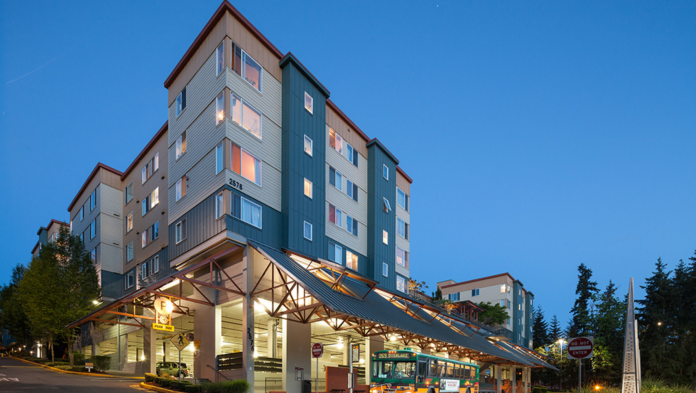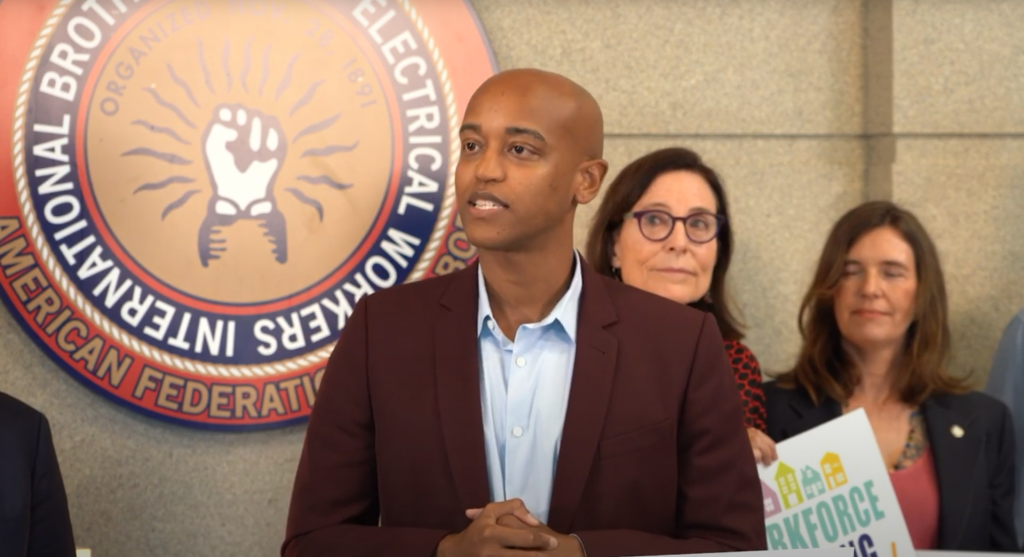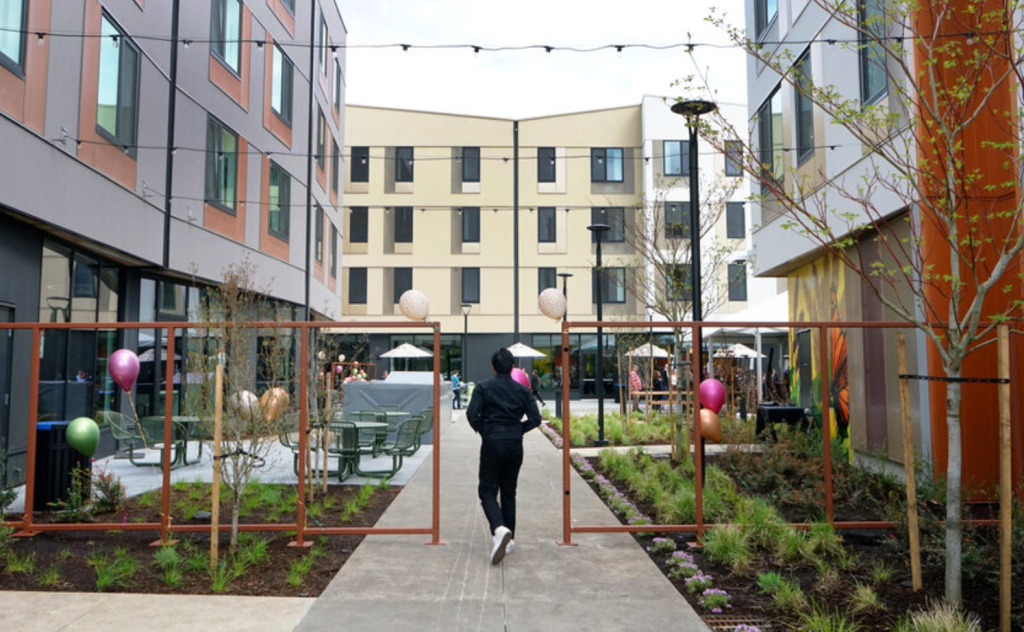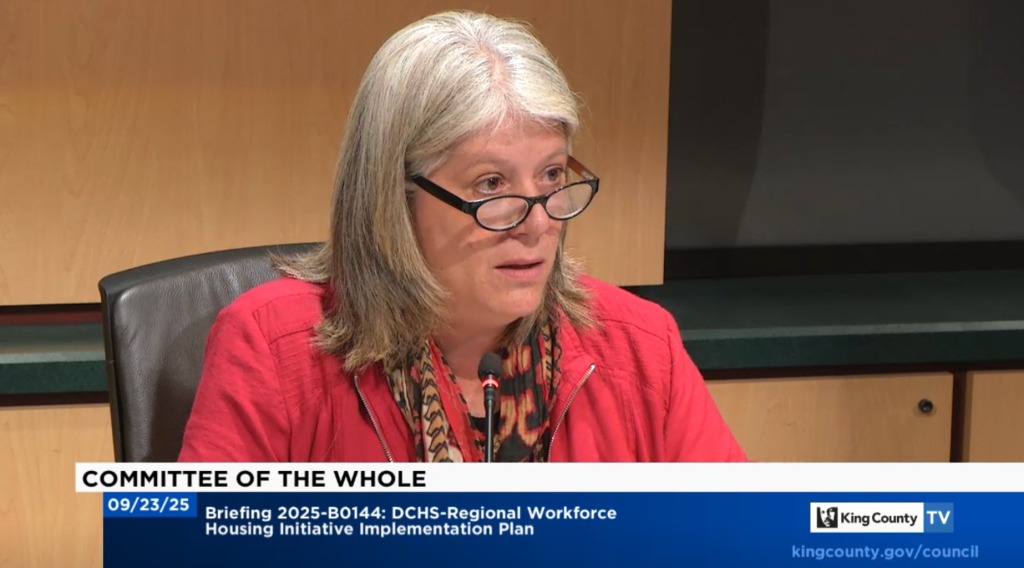
A report quietly transmitted earlier this summer spells out significant constraints King County would face to leverage existing bonding capacity as a standalone asset to build affordable “workforce” housing for middle-income residents. King County Councilmember Girmay Zahilay put forward the bonding idea last year, putting forward a motion directing then-Executive Dow Constantine to create an implementation plan. The motion was approved in an 8-1 vote.
The fledgling proposal quickly became a major election plank for Zahilay after he announced a King County Executive bid in December. Under affordability accomplishments, Zahilay’s campaign website touts that he “championed the Regional Workforce Housing Initiative, directing King County to invest $1 billion in publicly-owned, rent-restricted housing for essential workers.”
Zahilay is the frontrunner after finishing 14 points ahead of King County Councilmember Claudia Balducci in August primary results. He will now go head-to-head with Balducci in the November general election to lead Washington’s largest county. (The Urbanist’s elections committee, on which I serve with 13 other members, has endorsed Balducci.)
While the candidate is gaining momentum, his housing initiative appears to be losing it. Despite the King County Council receiving the report in late June, the report’s findings did not get a public airing until late September, just as the council headed into two months of budget deliberations.
King County has around $9 billion in capacity to issue bonds that it historically hasn’t tapped into, generally only issuing bonds when it has dedicated a specific revenue source available to pay them back. In contrast, Zahilay’s proposal was specifically touted as self-sustaining.
“I am proposing legislation that will establish a $1 billion Regional Workforce Housing Initiative, a bold and sustainable approach to increasing our housing supply without necessarily relying on new regressive taxes,” Zahilay wrote in an op-ed in The Urbanist explaining his proposal. “King County has approximately $9 billion in untapped debt capacity, some of which we can use without jeopardizing our financial health. By issuing bonds, we can borrow billions of dollars from banks at relatively great interest rates, then use these funds to construct thousands of permanently affordable housing units specifically designed for essential workers. The rental income generated from these units would then be used to pay down the loan, making the initiative self-sustaining and more affordable over time.”

But such a plan likely won’t move forward until the County identifies a new funding source to pair with its bonding capacity, the report states — a tall order given the constraints that exist on King County’s ability to raise revenue and the need to address existing structural budget gaps driven by inflation, population growth, and Trump’s deep budget cuts. In its first five years, the sample plan developed by the Executive’s office estimated an additional $158 million in new revenue would be needed to sustain $1 billion in bonds, with most of that money simply going to pay debt service on those bonds.
“This Plan finds that County bond financing can provide relative benefit to workforce housing but is not sufficient on its own to meaningfully address the gap between development and operating costs and the income from rents or home sales affordable to workforce households. Therefore, the County will need to provide additional support for workforce housing projects to ensure these regional affordable housing needs are met. To utilize $1 billion in County bonds as envisioned in the Motion, new revenue authority in addition to bond authority is necessary.”
Zahilay’s proposal mirrored Seattle’s new social housing developer, targeting middle-income residents who would be able to pay high enough rents to be able to sustain the program’s operational needs. But Seattle’s newest housing authority does have access to a dedicated revenue source, with voters signing onto a new high-earner payroll tax that is expected to generate around $50 million per year.
The report looked at other bond-financed housing programs in places like Maryland’s Montgomery County, Denver, and the state of Oregon to discover potential barriers to implementing such a program at King County. The primary takeaway? King County lacks a flexible revenue source to be able to cover unexpected losses.
“King County’s lack of flexible taxing authority presents challenges to being able to take a similar risk exposed program to those detailed below,” the report notes before describing those programs. “The cap on property taxes results in a lack of sufficient authority over the General Fund to adjust revenues if a project needs to be bailed out and doesn’t have sufficient revenue to pay for the debt service.”
Oregon’s Metro Council went to the voters for $652 million in general obligation bonds to fund affordable housing projects across a three-county area in 2019, but that program is funded by a dedicated property tax levy in the same way that Seattle’s housing levy is. King County consistently goes to the voters for approval on levies to keep specific funding streams intact, including this year with a regional fingerprint identification levy, a parks levy, and a Medic One/EMS levy this fall, but has not to date proposed a dedicated housing levy.
Until such time as the state offers more revenue tools to counties, sending a property tax levy to voters would appear to be the most straightforward path to stand up a county housing initiative. Zahilay has stopped short of proposing such a step, but Balducci has expressed interest in launching that conversation. In fact, she was already making that point last October when the county council greenlit the study.
“We heard it said that this is a way to provide a lot more financing for housing without any additional taxes,” Balducci said at the time. “I don’t know that that’s the case. I think we may find at the end of the day that we need new funding tools. And I’m here to say I’m not afraid of that. We should have that conversation about the need for new funding tools. And if we do have that conversation, bonding against a dedicated housing revenue stream could be an extraordinarily powerful combination.”

King County already uses bonding to fund affordable housing, via the Transit-Oriented Development and Health Through Housing programs. This year, the county’s Housing Finance Program (HFP) made $38 million in funding available for non-profit housing providers across King County, with project awards set to be made early next year.
At a September 23 discussion of the workforce housing report hosted in the council’s Committee of the Whole, which Balducci chairs, Zahilay framed the workforce housing report as a positive step exactly in line with what his expectations for the motion were.
“I think the report did exactly what we asked it to do,” Zahilay said. “It showed us clearly what’s feasible, what’s not, where the gaps are, what the risks are, and what it would take to make a workforce housing initiative work. And I think it’s not surprising that in this high-cost, high interest rate environment, that we learned that bonding alone doesn’t fully close the gap, but I think the model does work if paired with external sources. I think they mentioned external revenue sources, and that’s important information. And it means that this idea can be alive and very much worth pursuing as new revenue sources become available or or existing ones like the hotel motel tax become healthier in the future.”
On the other hand, Balducci painted the report’s results as more sobering.
“There were a lot of expert partners at the table who gave their input into this, and it found, not unsurprisingly, that they would not recommend a large bonding program without an associated revenue source,” Balducci said. “So it truly is no free lunch. Like, surprise: we have rediscovered the maxim. There are no other programs that they identified that do something similar without subsidies. There are no other models that were identified where rents were able to fully cover the cost recovery for capital construction or acquisition, including principal and interest. And there’s a reason for that, because there’s no free lunch.”

Zahilay’s office told The Urbanist that he’ll be prioritizing other issues ahead of the workforce housing initiative in the county’s biennial budget, which the council is considering now.
“In this budget, our immediate focus is on protecting core services and addressing urgent shortfalls across housing, health, and public safety. That said, the Regional Workforce Housing Initiative remains part of my long-term housing strategy,” Zahilay’s office said through spokesperson Rosa Mai. “The report makes clear that bonds alone aren’t enough right now and that a dedicated revenue source is needed to make the numbers work. Because that dedicated revenue source is not currently available, that means we have to be strategic about timing. In the meantime, I am committed to keeping the groundwork alive: confirming the legal basis for workforce housing bonds, exploring pilot programs like acquisition and conversion loans, and looking at updates to the credit enhancement program.”
Why didn’t the report get a hearing earlier? Zahilay’s office told The Urbanist that it was up to Budget Committee Chair Rod Dembowski to schedule such a discussion, and that other issues had taken precedence ahead of the workforce housing initiative. Dembowski, who officially announced his endorsement of Zahilay last week, had appeared next to him at the announcement of the workforce housing initiative last September.
“The timing of budget committee briefings is set by the Budget Chair. My understanding is that when the report was completed this summer, the budget committee was focused on urgent items such as Harborview, MIDD [the Mental Illness and Drug Dependency sales tax hike], and Crisis Care Centers,” Zahilay’s office said. “Since the workforce housing plan did not have immediate deadlines, it was reasonable to prioritize limited committee and staff time for those time-sensitive items and schedule the workforce housing discussion for budget season.”
On top of a busy council calendar, both candidates are navigating a county executive race that, as a contest between two Democrats, could be decided by which way the county’s Republican voters swing. Rather than new taxing initiatives, both candidates have been emphasizing messages of budget discipline and fiscal prudence since the primary.
Regardless of which candidate prevails in next month’s election, it remains very unclear what the future of the workforce initiative will be, given that similar funding challenges are likely to persist for the foreseeable future.
Ryan Packer has been writing for The Urbanist since 2015, and currently reports full-time as Contributing Editor. Their beats are transportation, land use, public space, traffic safety, and obscure community meetings. Packer has also reported for other regional outlets including BikePortland, Seattle Met, and PubliCola. They live in the Capitol Hill neighborhood of Seattle.

